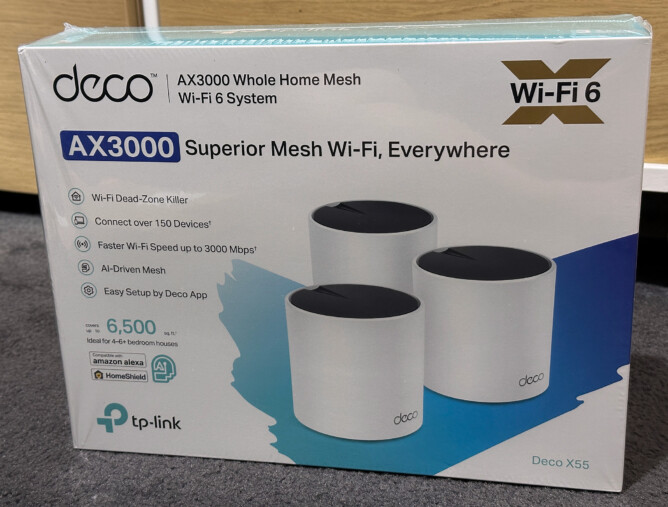
Mesh WiFi is my choice for home network because of its ability to reach every corner of my house. Since the main router and its satellite units create a unified network, we get to enjoy better network quality compared to a system with WiFi extenders. Modern mesh WiFi would automatically serve devices from the closest point that would result in better performance. This is especially handy for devices that moves regularly, such as mobile phones and tablets.
I started my experiment with mesh WiFi back in 2022 with Google Nest Wifi. I was pleasantly surprised with the performance of my home network when I started, but then things got worse as I have more and more devices in the home network. By the time I hit around 40+ devices online, my network became unstable and I often need to restart my routers. Combined with the fact that I have more and more devices with WiFi 6 capability, I decided it is time to upgrade my home WiFi system.
My choice went to TP-Link Deco X55, a mesh WiFi 6 with speed up to 3000 Mbps, capable to handle over 150 devices. I decided to go with Deco series because I could upgrade it with newer model in the future and I can still use my current unit for the less important areas in the house.
Each unit of Deco X55 has 3 gigabit ethernet ports, capable to deliver AX3000 Dual Band Wi-Fi within area of 600 square metres. TP-Link claims that this system is AI-driven, but I do not really care about that. I mean, every single product in the market will try to claim to have something to do with AI in today’s market when they can. The units feel surprisingly lightweight, especially for me with experience handling heavier Google Nest Wifi units.
Setting up is quite easy. We download an app from TP-Link and follow the easy guide from the app. I am genuinely impressed with the level of control the app lets me to configure. We can see all the devices connected to the network, their MAC address and IP address, the mesh unit serving the device and which frequency it is at. We can set a nickname for each device to make it easier to remember and assign an icon to indicate what kind of device it is. We could set a few devices as high priority, or we can set speed limit.
By default, each device will be served by the closest mesh unit that would allow highest performance. But we could opt to force a device to only connect to one particular mesh unit, if we need to. We can isolate a device so that all it gets is internet connection and it cannot connect to any other devices in the network. This could be particularly useful with some IoT devices. I turned off the IoT network functionality a few hours after my first experiments though. It basically rendered my HomeKit devices unusable, and I just could not figure out this feature.
Useful parental control allows us to define child profiles and associate some devices to them. Some more advanced parental features are locked for users who pay for the optional subscription. I found that the basic features are sufficient, allowing us to see which websites are visited and allow us to block network access.
Camera security feature lets us define some devices as cameras and apply some controls to them, such as making sure they only have access to local network and will not upload the recording to a cloud server. WiFi access control gives us the choice whether we want to allow new devices by default. QoS (quality of service) feature allows user to prioritise online conferences, streaming, games, file transfer or social media.
Other notable features include reboot schedule, connection alerts, VPN, WPS, guest network, DHCP address reservation and port forwarding. Last but not least, X55 has a capability to add Matter devices into its Smart Home feature. So far I have successfully added smart sockets from TP-Link Tapo into the system.
In the first few weeks of use, I enjoy the noticeable improvement on speed. Network is generally more stable and the fact that I could force my phone to 2.4GHz network helps me to set up some of my smart devices. Thanks to the reboot schedule (which I set to reboot my router once a week at 2am), I rarely need to manually restart my WiFi anymore, except when I need to update my IP address reservation.
On the negative side, my Teams video conference, however, would still randomly drop off sometimes. I am unsure whether this is caused by the router or my ISP. I just found that there is an option to prioritise online conferences yesterday. I shall see if this QoS feature would solve my issue.
Overall, I am quite happy with this upgrade. Will experiment some more before I sell my old Google Nest Wifi. I have high hope that this WiFi system should survive for the foreseeable future because I will not gain much benefit from WiFi 7. The maximum speed of nbn fibre in Australia today is embarrassingly low at 1000 Mbps. With my current WiFi capable of 3000 Mbps, what more do I need?

Leave A Comment